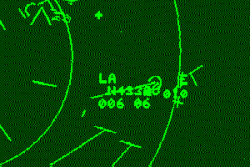Hot Fun In The Summertime?
 It has been a pretty good month in thePilot’s Lounge. Summer is here and the airplanes are beautiful. For the secondyear in a row we have had great weather, so the old saw, “what comes aftertwo days of rain in Michigan? Monday” is not holding up. As one of thepilots in the lounge said, “If this is global warming, give me more.”We sent her out to sweep a hangar.
It has been a pretty good month in thePilot’s Lounge. Summer is here and the airplanes are beautiful. For the secondyear in a row we have had great weather, so the old saw, “what comes aftertwo days of rain in Michigan? Monday” is not holding up. As one of thepilots in the lounge said, “If this is global warming, give me more.”We sent her out to sweep a hangar.
Some of the folks have been getting in trouble at home because they can’tbring themselves to go home on these lovely, soft evenings. After all, how canyou leave when you see Sandy slipping the Citabria over the trees and gracefullystraightening out during the flare? When you realize you can’t tell the exactmoment the tires started rolling on the ends of the grass you just standmesmerized. Landings like those, on a perfect summer evening, are something tobe bottled and kept forever. When the snow is blowing and you can’t even get tothe airport, pull out the memory and just savor it. No wonder it’s impossiblefor most of us to leave until it gets dark.
We’ve pulled the chairs from the Lounge outside where we can watch theartistry of little airplanes in the sky. We shamelessly indulge in thetime-honored activity of critiquing landings and continue to talk about flyingas we always do. The talk during the month has been about two subjects, onewhich pleases all of us and one which is just plain scary because it may be atip of an iceberg. The very pleasant subject was some correspondence passedalong to us from the Atlanta Air Route Traffic Control Center (ARTCC).
Kudos To Atlanta Center
Last month, I was critical of one phase of Atlanta ARTCC’sCatch A Bad Altitude program. That portion was the process of making tapes ofpilots who improperly read back altitude clearances and sending them to theirairline employer. I was concerned that it could result in a job action againstthe pilot. To their everlasting credit, Atlanta ARTCC has dropped that portionof the program.
A Brief History…
 To recap, if a pilot misreads an altitude clearance and a controller catchesit and corrects the pilot, it has historically meant that a potential midair wasavoided. As a pilot, I am all for controllers who catch my mistakes before I dosomething stupid. Now, Atlanta ARTCC has put up an additional carrot for thecontroller. After the correction the controller is eligible for a $50 giftcertificate. That took some creativity and effort on the part of the folks atAtlanta.
To recap, if a pilot misreads an altitude clearance and a controller catchesit and corrects the pilot, it has historically meant that a potential midair wasavoided. As a pilot, I am all for controllers who catch my mistakes before I dosomething stupid. Now, Atlanta ARTCC has put up an additional carrot for thecontroller. After the correction the controller is eligible for a $50 giftcertificate. That took some creativity and effort on the part of the folks atAtlanta.
In the last couple of weeks, AVweb received detailed email from ElizabethRay and Mark Ward, managers at Atlanta ARTCC. They have explained the purpose ofthe Catch A Bad Altitude program and the fact the sending of tapes was dropped.In a nutshell, the timing of the program – coming just after the FAA issued itsinfamous “interpretive rule” on clearance readbacks (making pilotsstrictly liable for a mistaken clearance readback if the controller doesn’tcatch the mistake) – was precisely as we suspected, a coincidence. The FAA inWashington did not coordinate the interpretive rule with the FAA employees doingthe work of controlling aircraft in the real world. Thus, Atlanta ARTCC wasunfairly tarred for its timing of its program, just when pilots were extremelysuspicious of anything the FAA might do.
 The purpose of Atlanta’s program is system improvement. They want to see ifthey can find out whether the problem of bad altitude readbacks are moreprevalent in particular sectors, or among pilots not wearing headsets or atparticular times of day or if there are some other variables which can beidentified as culprits. They expressed concern because Atlanta generally issuesmore holding clearances than other Centers and felt, but had no data, that thecomplexity of clearances increased the risk of altitude readback errors. Theywant data to work with and this program is a very good way to obtain it.
The purpose of Atlanta’s program is system improvement. They want to see ifthey can find out whether the problem of bad altitude readbacks are moreprevalent in particular sectors, or among pilots not wearing headsets or atparticular times of day or if there are some other variables which can beidentified as culprits. They expressed concern because Atlanta generally issuesmore holding clearances than other Centers and felt, but had no data, that thecomplexity of clearances increased the risk of altitude readback errors. Theywant data to work with and this program is a very good way to obtain it.
The Atlanta ARTCC has 300 to 400 erroneous altitude readbacks per month.That’s staggering. The VAST majority of errors are air carrier. Atlanta wants toreduce the number markedly. The folks there also want your ideas as to how to goabout it. I don’t think they have a big budget for the program. So, the idea of collecting tapes and using a computer to distort the voice qualities andediting out call signs probably wouldn’t work. I still think that creatingtranscripts of the transmissions with call signs redacted could result inexcellent learning tools for pilots. Circulating the transcripts of severalhundred errors might help us pilots do a better job. We might also identifycircumstances when we pilots are more likely to make errors and be on the watchfor them.
Editor’s Note: AVweb has learned that Atlanta ARTCC’s Catch A Bad Altitude program has garnered the attention of the FAA’s top brass in the Flight Standards Division and in its legal department. The issue seems to be whether Atlanta ARTCC should have developed and implemented the CABA program without gaining the approval of FAA headquarters.
I’ll say it again, Atlanta Center, you are to be commended for your effortsto improve safety. I firmly believe that the pilot-controller relationship isone of teamwork and I’m pleased that you have instituted this innovative programto help the pilot-controller team work even better together.
Now The Bad News
While the habitues of the Lounge discussed the good news coming from AtlantaARTCC, one of our regulars, an FAA employee, took me aside for a talk. I wasasked if I had read the material on Land and Hold Short Operations(LAHSO). [NOTE: An FAA brochure describing theLAHSO program is available in Adobe’s Portable Document Format. The file islarge, around one megabyte.] Isaid I’d seen some comments about it in magazines and some pretty negativeeditorials and heard some questions about go-around procedures, but simplyhadn’t gotten anything official. I’d been offered one land and hold shortclearance but before I’d even been able to respond the controller cleared me toland on another runway which had no intersecting runway.
The next thing I knew I was handed an internal FAA Bulletin, FSGA 99-02,”General Aviation 14 CFR Parts 91 and 125 Land and Hold Short Operations(LAHSO),” effective March 30, 1999. I started looking at the bulletin andskimmed through the discussions of landing distances for various airplanes andthat neither student pilots nor pilots flying experimental airplanes mayparticipate. My lips were starting to get tired from all the reading when I sawsomething that stopped me cold:
“Title 14 CFR, Part 91 operators (that’s us, folks) shall, using one or more of the Knowledge Based Training Methodologies outlined below, become completely familiar with and have a good basic understanding of LAHSO procedures PRIOR TO ACCEPTING A LAHSO CLEARANCE.
Don’t Get LAHSO’d
Did you know that you cannot accept a LAHSO clearance unless you havecompleted one of four specific types of approved FAA training procedures?
Okay class, show of hands: How many of you flying Part 91 have accepted aland and hold short clearance? Had you completed the FAA’s “Knowledge BasedTraining” prior to doing so? According to the FAA’s internal bulletin, notsent out to pilots, you could not legally accept the clearance. Doesn’t thatmake you feel wonderful?
| You cannot legally accept a land and hold shortclearance under Part 91 until you have been completed approved training. No,there is no FAR to that effect, just an FAA internal pronouncement. If youaccept a clearance and blow the landing, then get busted, it is likely the FAAwill also violate you for accepting the clearance illegally. You have justviolated double secret probation. |
Yes, according to my source, the incongruity of the whole thing has been passedback up the chain within the FAA but there has been nothing rescinding oramending the bulletin as of yet.
So, pilots have no way of knowing they cannot accept a land and hold shortclearance until they have received the training which will allow them to acceptthe clearance and tells them they couldn’t accept the clearance before takingthe training. Thanks, FAA, for bringing Catch-22 into the 1990s.
Therefore, until you get the training, don’t accept a land and hold shortclearance. You cannot legally do so. By the way, according to the bulletin theapproved training is one of, or a combination of the following:
a. A review of the pertinent sections of the Aeronautical Information Manual (it was to be revised about the time of the bulletin);
b. Attendance at FAA and/or industry safety education seminars that include LAHSO as an emphasis topic;
c. Successful completion of a flight review (we used to call it the BFR) containing procedural guidance on LAHSO operations, and;
d. Successful completion of a flight instructor refresher clinic that includes guidance on LAHSO operations.
The Bottom Line…
You heard it here first: You cannot legally accept a land and hold shortclearance under Part 91 until you have completed approved training. No,there is no FAR to that effect, just an FAA internal pronouncement. If youaccept a clearance and blow the landing, then get busted, it is likely the FAAwill also violate you for accepting the clearance illegally. You have justviolated double secret probation. It will be very interesting when the first oneof those violations gets appealed to the National Transportation Safety Board.It’s not often that the NTSB slaps down the FAA for improper actions, but whenit happens, it’s fun to watch. The FAA didn’t even give lip service to therequirement for public comment before imposing a new rule on this matter.
I don’t know if latter March/early April was a time of increased internalstress at the FAA, but in a matter of days, the FAA conducted rulemaking byadministrative fiat. It published the horrendous interpretive rule attempting tochange the tenor of the regulations on pilot responsibility for ATC readbackerrors and it put out this bulletin requiring a pilot to have specializedtraining before accepting a particular type of ATC clearance.
It is bad enough that the FAA seems to be bound and determined to get around therequirement to submit proposed new regulations for public comment by callingregulations something else and simply issuing them, but to then make a new ruleand not tell pilots about it is Kafkaesque. Are there other rules in internalbulletins we don’t know about? How big is this iceberg? I guess we are only tolearn of them when we violate one. Law enforcement of that sort is the kind ofthing that starts revolutions.
…The Season Of The FAA’s Discontent?
Keep your eyes open; the top folks at the FAA seem to be in the mode ofavoiding public comment and doing end runs around the rule-making process. Mostrecently, the FAA attempted to simply issue a very involved AD on turbochargedtwin Cessna exhaust systems without going through the normal Notice of ProposedRulemaking by essentially claiming the AD was of an emergency nature. AVweb,the Cessna Pilots Association and AOPA raised a stink and the AD is now going togo out for comment for a very short period. The top echelon of the FAA isignoring the input of the pilots whom they are supposed to be serving.
Personally, I am glad my EAA and AOPA dues are up to date. When dealing witha 900-pound gorilla it is wise to have some firepower on your side. Theeconomist John Kenneth Galbraith wrote about countervailing powers some yearsback. He was ahead of his time. When individual pilots face a massivebureaucracy our only hope is to band together in the hopes of having the kind ofpower needed to have an effect on that bureaucracy. It also certainly doesn’thurt to write to your representatives in Congress frequently.
So, say nice things to Atlanta ARTCC, but don’t accept any land and hold shortclearances until you’ve been trained.
See you next month.


































